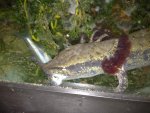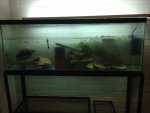Hey all,
I'm new to respond to the site, but have been perusing through here for a while! A wealth of information here.
Today, I am curious how many of you house the Necturus maculosus (and various subsp.), and possibly together, we can make the Necturus a feasible creature to care for! I've seen many sick Necturus being kept, and half of the problem is tank size and water temperature! Lowering the temperature is key to getting good oxygenation! I'd like to ask the Necturus keepers and breeders to brag about their mudpuppies! There are many factors in keeping the Necturus, but honestly, it is nothing too crazy or complicated. Common sense and a good understanding of the species' in situ is what is needed to duplicate what they need to thrive!
Here are my questions for the Necturus keepers; What size tank (or setup), water quality (and do you utilize RO?), pumps and sumps (how it is all setup), substrate, plants, rocks and other media for hiding, what is used to put oxygen in the water (to avoid Gas Bubble Disease), overall housing temperature (medium and winter temps) and what is used to bring the temperature to what the Necturus requires?
In the next week, I will demonstrate how a person can avoid the costly expenses of an inefficient compact water chiller that brings temperatures down like 15F degrees, and have a great Necturus setup for under $550. The most important part of housing a Necturus, is the health and well being of the creature!
I'm new to respond to the site, but have been perusing through here for a while! A wealth of information here.
Today, I am curious how many of you house the Necturus maculosus (and various subsp.), and possibly together, we can make the Necturus a feasible creature to care for! I've seen many sick Necturus being kept, and half of the problem is tank size and water temperature! Lowering the temperature is key to getting good oxygenation! I'd like to ask the Necturus keepers and breeders to brag about their mudpuppies! There are many factors in keeping the Necturus, but honestly, it is nothing too crazy or complicated. Common sense and a good understanding of the species' in situ is what is needed to duplicate what they need to thrive!
Here are my questions for the Necturus keepers; What size tank (or setup), water quality (and do you utilize RO?), pumps and sumps (how it is all setup), substrate, plants, rocks and other media for hiding, what is used to put oxygen in the water (to avoid Gas Bubble Disease), overall housing temperature (medium and winter temps) and what is used to bring the temperature to what the Necturus requires?
In the next week, I will demonstrate how a person can avoid the costly expenses of an inefficient compact water chiller that brings temperatures down like 15F degrees, and have a great Necturus setup for under $550. The most important part of housing a Necturus, is the health and well being of the creature!


